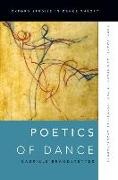Read more
The book looks at dance at the beginnings of the 20th century, the time during which modern dance first began to make its radical departure from the aesthetics of classical ballet. Author Gabriele Brandstetter traces modern dance's connection to new innovations and trends in visual and literary arts to argue that modern dance is in fact the preeminent symbol of modernity.
List of contents
Introduction; Part I: Pathos Formulas. Body-Image and Danced Figuration; 1. Dance in the Museum: Body and Memory; 2. Patterns of Femininity and the Body-Image of Dance; 3. Delirium of Movement and Trance Dance; 4. The Dancer as Muse; Part II: Topos Formulas. Dance Movement and Figuration of Space; 1. Dance Costume and Movement Space: Spatial Formulas and their Metamorphoses into Fabric; 2. Dance-Text. Transformations of Choreography; 3. Aerodance. Futurist Dance and Aviation; 4. Writing Dance and Spatial Writing. Between Alphabet and Topos Formula; 5. Interruption Intermediality and Disjunction in the Movement Concepts of Avant-garde Dance and Theater; Conclusion; Bibliography; Index
About the author
A scholar of widespread international recognition, Gabriele Brandstetter is Professor for Theatre and Dance Studies at the Freie Universität Berlin, where she founded and directs the Centre for Movement Studies. She is also co-director of the International Research Center "Interweaving Performance Cultures". She is author of three scholarly books and editor or co-editor of ten scholarly books on dance and movement.
Summary
When it was first published in Germany in 1995, Poetics of Dance was already seen as a path-breaking publication, the first to explore the relationships between the birth of modern dance, new developments in the visual arts, and the renewal of literature and drama in the form of avant-garde theatrical and movement productions of the early twentieth-century. Author Gabriele Brandstetter established in this book not only a relation between dance and critical theory, but in fact a full interdisciplinary methodology that quickly found foothold with other areas of research within dance studies.
The book looks at dance at the beginnings of the 20th century, the time during which modern dance first began to make its radical departure from the aesthetics of classical ballet. Brandstetter traces modern dance's connection to new innovations and trends in visual and literary arts to argue that modern dance is in fact the preeminent symbol of modernity. As Brandstetter demonstrates, the aesthetic renewal of dance vocabulary which was pursued by modern dancers on both sides of the Atlantic - Isadora Duncan and Loie Fuller, Valeska Gert and Oskar Schlemmer, Vaslav Nijinsky and Michel Fokine - unfurled itself in new ideas about gender and subjectivity in the arts more generally, thus reflecting the modern experience of life and the self-understanding of the individual as an individual.
As a whole, the book makes an important contribution to the theory of modernity.
Additional text
Gabriele Brandstetter's book is of magnificent scope and depths moving towards nothing less than a theory of the avantgarde in early 20th century Europe. Considering the dancer's body as a form of writing oscillating between memory and metamorphosis, dance becomes the main site on which the cross cultural transformations between the past and the present, the mundane and the exotic were negotiated. The dancer's body thus becomes a symptom for the fundamental changes of both the cultural systems and the systems of art that make up the culture of modernity - touching on topics like ritual, exotism, and its gender related issues, Brandstetter engages in a 'lecture corporelle' that reads dance as a series of figurations of emotions and space, of pathos formulas and topos formulas, that allow us to re-read the culture of modernity across all disciplines in its conscious and unconscious manifestations.

